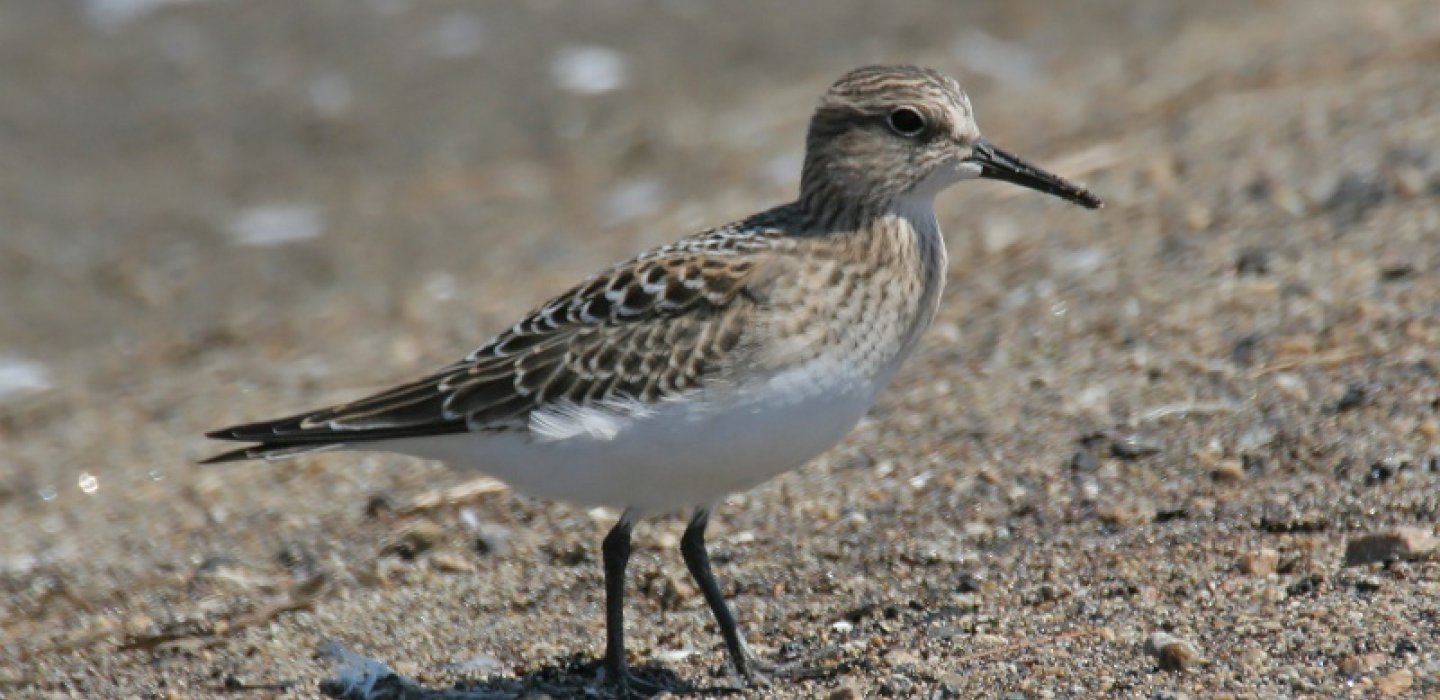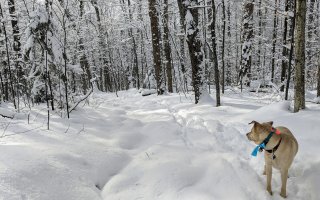
A Rainy Start with Migrants!
I woke in my sleeping bag to the sound of thunder and rain on the tent and I lay in the darkness listening while stroking Wren's soft ears and head. I had planned on getting up, but I didn't want to take down the tent in the rain and so I chose a more relaxing start to the day. And this delay didn't seem to matter much -- as I lay there I could hear Wood Thrushes calling low overhead as they migrated south beneath the gray ceiling of clouds along the St. Lawrence River. They were joined by the chip notes of other migrants, and as the rain abated, I finally roused myself, even though I didn't want to disturb our peaceful tranquility.

We were camped at Coles Creek State Park in the northeast corner of St. Lawrence County and planning to work our way along the St. Lawrence River back into Franklin County. The drippy, misty morning seemed to have knocked down a nice assortment of migrant songbirds - the exact thing I'm looking for during this time of year. I took down the tent and we went for a walk around the campground in the gray, wet air. I found a small tree with six Scarlet Tanagers, a few other trees which were hosting about 10 Baltimore Orioles, and I began a warbler list which eventually numbered nine species on our short outing. They included a Cape May and a Bay-breasted Warbler, as well as several Tennessee Warblers -- all arriving from Canada. A second flock of birds was flitting in the trees near the sand strip of beach where people let their dogs swim, so Wren played in the sand and I looked through still more warblers -- and more Tennessees.
Shorebirds
We reluctantly (I because of the bird activity and Wren because she was having a blast swimming!) returned to camp to eat breakfast and finish packing up. Then we were off to Wilson Hill Wildlife Management Area, a stone's throw east along the river. The east pool at Wilson Hill has been drained by managers this year and in recent weeks birders have been finding a variety of shorebirds as a result - including Red-necked Phalarope, Buff-breasted Sandpiper, Short-billed Dowitcher, and Baird's Sandpiper -- all nice finds in the North Country.
We arrived at Route 131 and its tower to scope the mudflats just after a Merlin had chased up many of the shorebirds, but we still found both Greater and Lesser Yellowlegs, Killdeer, a Spotted Sandpiper, and a group of 13 Black-bellied Plovers. I also spotted a Bonaparte's Gull mixed in with some of the more common Ring-billed Gulls. Then we moved on to the causeway viewing area where a friend of mine was scoping through a large group of Semipalmated Plovers, Semipalmated Sandpipers, and Least Sandpipers which had included a few Baird's Sandpipers. After a little more looking, we re-found the Baird's. Soon after that we added a Green Heron, but after not finding any new shorebirds, my friend headed back home and I continued on into the Wildlife Management Area.
Exploring Wilson Hill Further
It was growing warmer by this time in the day so Wren and I drove sections of the gravel roads, and walked others -- the roads are currently open to birders through August 27 (they are always open in August for two weeks out of the year, otherwise some places are off limits). We added species like Great Blue Heron, Pied-billed Grebe, Osprey, Bald Eagle, Cooper's Hawk, Broad-winged Hawk, American Bittern, and Common Gallinule -- one family group of which held five cute, fluffy chicks. We also scoped out both West Pool and the western side of East Pool -- spotting four Sandhill Cranes in the process.

With the day growing even hotter, I decided to head toward home - but not before stopping to see if any new shorebirds had arrived on the mudflats in the meantime. I was glad that I did - in addition to our earlier species, I added five Pectoral Sandpipers to our tally, spotting them from Route 131. I also spotted a Great Egret flying overhead.
Northern Franklin County - and More Rain
It is a short distance from Wilson Hill into Franklin County, and Wren and I were soon checking out farm fields around towns like Hogansburg and Fort Covington. We found a lot more Killdeer and Great Blue Herons, as well as constantly feeding Barn and Tree Swallows, but I was more excited by the pair of Sandhill Cranes we noted along Chapman Road which runs toward the Quebec border from Drum Street Road. But even as we enjoyed the cranes, a line of rain and thunderstorms began to bear down upon us and I moved along more quickly than I originally planned, hoping to stay ahead of the wet weather for a spell.

But there wasn't much we could do to avoid the storm entirely and we were soon caught while birding along Mary Riley Road near Fort Covington. The rain pelted so hard that I sat along a quiet stretch of road and let the storm pass - it was impossible to see with so much water bucketing from the heavens! But as it cleared through I watched a bunch of Wood Ducks in a small farm pond, and checked the pond edges for migrating shorebirds before continuing toward Malone and then on to home.
And while the heavy rains may have scuttled some of my plans for that day, the front which pushed them is often what we are looking for during this time of year. Such cold fronts are the first of the season - bringing us not only a taste of autumn, but more importantly the migrant birds which we are hoping for during late summer and early fall. And so with many more such fronts to come, Wren and I will be out there searching for whatever the weather brings with it.
Late summer and early fall offer great birding across the Adirondacks and North Country. Plan your outdoor adventure today by checking out our lodging and dining pages!
This week in related ADK news:






Comments
Add new comment